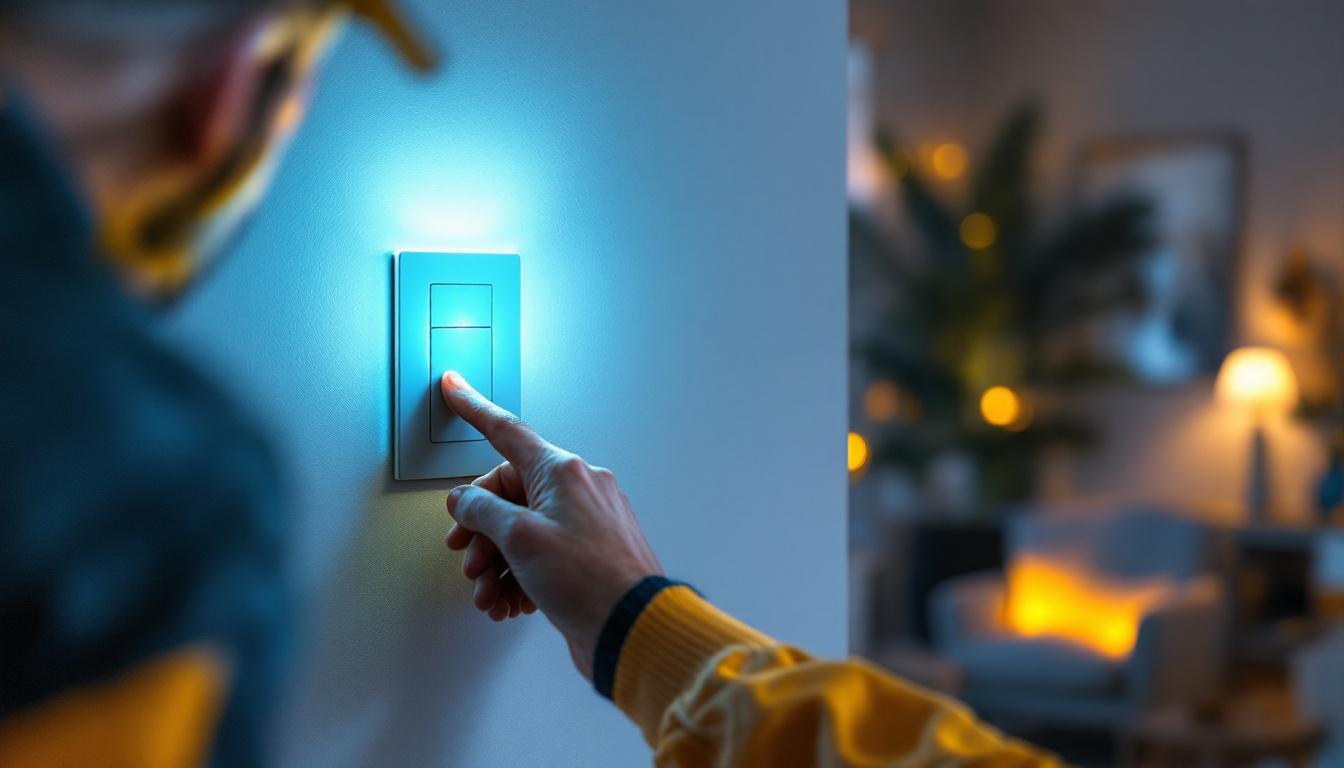
Lighting contractors are continually seeking innovative solutions to enhance their services while also managing costs effectively. One such solution that has gained traction in recent years is the use of dimmable light switches. These devices not only provide flexibility in lighting design but also contribute to significant cost savings for both contractors and their clients. This article explores the benefits of dimmable light switches, how they can reduce costs for lighting contractors, and the factors to consider when integrating them into projects.
Dimmable light switches allow users to adjust the brightness of their lighting fixtures, providing a customizable lighting experience. Unlike traditional switches that simply turn lights on or off, dimmable switches enable a spectrum of brightness levels, which can enhance the ambiance of a space. This functionality is particularly valuable in residential and commercial settings, where lighting needs can vary widely throughout the day. For instance, a bright setting may be ideal for daytime activities such as reading or working, while softer lighting can create a relaxing environment for evening gatherings or intimate dinners.
There are several types of dimmable light switches available on the market, each designed to cater to different lighting systems and user preferences. The most common types include:
Each type has its advantages and can be chosen based on the specific needs of a project. For example, in a home theater, a smart dimmer might be ideal for creating the perfect movie-watching atmosphere, while a rotary dimmer could be sufficient for a cozy reading nook.
The advantages of incorporating dimmable light switches into lighting designs extend beyond mere aesthetics. Here are some key benefits:
Additionally, the ability to control lighting levels can be particularly beneficial in spaces that serve multiple functions. For example, a dining room can transition from bright lighting for family meals to a softer glow for entertaining guests, allowing for versatility in how the space is used. Moreover, the aesthetic appeal of dimmable lighting can complement various interior design styles, enhancing the overall décor and making spaces feel more cohesive and thoughtfully designed.
For lighting contractors, the integration of dimmable light switches can lead to several cost-saving opportunities. These savings can manifest in various ways, from reduced energy bills for clients to lower maintenance costs for contractors.
One of the most immediate benefits of installing dimmable light switches is the potential for lower energy bills. By allowing users to adjust lighting levels according to their needs, dimmable switches can significantly reduce electricity consumption. This is particularly beneficial in commercial spaces, where lighting can account for a substantial portion of energy costs.
Lighting contractors can market this energy efficiency to clients, emphasizing the long-term financial benefits of investing in dimmable technology. This not only enhances the contractor’s value proposition but also positions them as environmentally conscious professionals committed to sustainability.
Another area where dimmable light switches can lead to cost savings is in maintenance and replacement costs. Traditional light fixtures often burn out quickly when used at full brightness for extended periods. In contrast, dimmable switches allow for a softer light that can extend the life of bulbs, reducing the frequency of replacements.
For contractors, this means fewer service calls and less time spent on maintenance tasks. Additionally, clients will appreciate the reduced need for bulb replacements, leading to higher satisfaction and potentially more referrals for the contractor.
Integrating dimmable light switches into lighting designs can also enhance the overall value of a project. Clients are often willing to invest more in properties that offer modern, energy-efficient solutions. By providing dimmable lighting options, contractors can differentiate their services and justify higher project costs.
This increased project value can lead to greater profitability for contractors, as they can command premium prices for advanced lighting solutions. Moreover, showcasing the benefits of dimmable lighting can help contractors win more bids and secure larger contracts.
While the benefits of dimmable light switches are clear, there are several factors that lighting contractors should consider when implementing them in their projects. Understanding these considerations can ensure successful installations and satisfied clients.
Before installing dimmable light switches, it is essential to assess their compatibility with existing lighting systems. Not all light fixtures are designed to work with dimmers, particularly older incandescent or fluorescent bulbs. Contractors should conduct thorough assessments to ensure that the chosen dimmable switches are suitable for the specific fixtures being used.
In some cases, upgrading to compatible LED bulbs may be necessary to achieve optimal performance. This additional step can enhance energy savings and improve the overall effectiveness of the dimming system.
Correct installation is crucial for the performance of dimmable light switches. Lighting contractors should adhere to manufacturer guidelines and best practices to ensure that the switches function as intended. This includes proper wiring, ensuring that the switch is rated for the load it will handle, and confirming that the installation complies with local electrical codes.
Additionally, educating clients on how to use the dimmable switches effectively can enhance their experience and satisfaction. Providing clear instructions and demonstrating the features can empower clients to make the most of their new lighting systems.
Finally, contractors should conduct a cost versus benefit analysis when considering the integration of dimmable light switches into their projects. While the initial investment may be higher than traditional switches, the long-term savings and enhanced project value can outweigh these costs. Assessing the specific needs of each project will help contractors make informed decisions that align with their business goals.
The lighting industry is continually evolving, with new technologies emerging that enhance the functionality and efficiency of dimmable light switches. Staying informed about these trends can help lighting contractors remain competitive and offer cutting-edge solutions to their clients.
One of the most significant trends in the lighting industry is the rise of smart lighting solutions. Dimmable light switches are increasingly being integrated with smart home technology, allowing users to control their lighting remotely or through voice commands. This added convenience appeals to tech-savvy clients looking for modern solutions.
Contractors can benefit from offering smart dimmable switches as part of their services, tapping into a growing market segment that prioritizes automation and connectivity. By staying ahead of the curve, contractors can position themselves as leaders in the industry.
As energy efficiency continues to be a priority for consumers and businesses alike, advancements in LED technology are making dimmable lighting even more effective. Newer LED bulbs are designed to work seamlessly with dimmers, providing a wider range of brightness levels without flickering or loss of quality.
Contractors should keep abreast of these developments and consider incorporating the latest energy-efficient technologies into their projects. This not only enhances the performance of dimmable systems but also aligns with the growing demand for sustainable solutions.
Future dimmable lighting solutions may also see increased integration with other building systems, such as HVAC and security. This holistic approach to building management can lead to enhanced energy efficiency and improved occupant comfort.
Lighting contractors should explore opportunities for collaboration with other trades to offer comprehensive solutions that address multiple aspects of building performance. This can lead to more significant project opportunities and increased client satisfaction.
Dimmable light switches represent a valuable tool for lighting contractors looking to enhance their services while reducing costs. By offering clients the ability to customize their lighting experience, contractors can improve energy efficiency, extend bulb life, and increase project value. However, careful consideration must be given to compatibility, installation techniques, and cost-benefit analysis to ensure successful implementation.
As the lighting industry continues to evolve, staying informed about emerging trends and technologies will be crucial for contractors seeking to remain competitive. By embracing dimmable lighting solutions and integrating them with other advanced technologies, lighting contractors can position themselves for success in a rapidly changing market.
Ready to harness the cost-saving power of dimmable light switches for your next project? Look no further than LumenWholesale, where we provide lighting contractors with the highest quality, spec-grade lighting products at unbeatable wholesale prices. Say goodbye to inflated markups and hello to superior lighting solutions that meet the most rigorous industry standards. With our hassle-free bulk buying and free shipping, you’ll enjoy premium lighting at the best value — all without hidden fees or compromises. Elevate your lighting game and experience the perfect blend of quality, affordability, and convenience. Visit LumenWholesale today and make the smart switch to cost-effective, efficient lighting for all your contracting needs.

Discover the insider tips and expert strategies lighting contractors use to master the art of outlet replacement.
Discover the reasons behind flickering light bulbs and learn how addressing this common issue can enhance your lighting business.

Discover the ins and outs of 3500K color temperature and its impact on lighting environments.

Discover why top-rated LED shop lights are the essential component missing from your lighting projects.